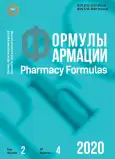Approaches to assessing the sexual behavior of male rats in the study of the effects of compounds that have a stimulating effect on sexual function
- Authors: Subbotina S.N.1, Kryazhevskikh A.A.2,3, Kryazhevskikh A.A.2,3, Yudin M.A.4, Eletskaya E.I.3
-
Affiliations:
- State Research Testing Institute of Military Medicine» Ministry of Defense of the Russian Federation
- State Scientific Research Test Institute of the Military Medicine Defense Ministry of the Russian Federation
- Saint Petersburg State Chemical and Pharmaceutical University
- State Scientific Research Test Institute of the military medicine Defense Ministry of the Russian Federation
- Issue: Vol 2, No 4 (2020)
- Pages: 98-103
- Section: Biomedical Sciences
- URL: https://journals.rcsi.science/PharmForm/article/view/46372
- DOI: https://doi.org/10.17816/phf46372
- ID: 46372
Cite item
Full Text
Abstract
The paper presents a comparative analysis of information content of methods for assessing the copulatory behavior of male rats with the introduction of compounds that have a stimulating effect on the sexual activity of animals. The social significance of the problem of sexual dysfunctions determines the relevance of the development of various experimental models of sexual behavior that allow assessing the effectiveness and safety of new drug. The probability of detecting the activating effect of pharmacological agents on sexual activity directly depends on the correct choice of the experimental model. The drugs of the central mechanism of action – galantamine hydrobromide (1 mg/kg) and loxidan (1,7 mg/kg), were used as pharmacological agents; drugs of peripheral action were yohimbine hydrochloride (2,6 mg/kg) and vardenafil hydrochloride (1,7 mg/kg). It has been shown that the determination of the stimulating effects of compounds of the central mechanism of action is possible using methods with different testing duration (from 15 to 180 min). Thus, the introduction of galantamine enhances the sexual activity of males in terms of the «copulation rate», «the number of perfect ejaculations» and «the duration of the post-ejaculatory refractory period», loxidan – in terms of the «total number of intromissions» and «relative rest time» in tests of limited duration. In the test showing the completed sexual cycle of males, the stimulating effects of galantamine are shown in terms of «the number of completed copulatory series» and «the number of completed ejaculations». To assess the activating effects of compounds of the peripheral mechanism of action, the expediency of using experimental models with a test duration of 30 minutes or more was shown. The most informative test is the test of paired interaction between a male and a female until the male reaches the state of «sexual exhaustion». A method with high information content is presented, which provides a high probability of detecting the activating effect of compounds on the sexual function of male rats.
Determination of the stimulating effects of compounds of the central mechanism of action is possible using methods with different test duration
Full Text
##article.viewOnOriginalSite##About the authors
Svetlana N. Subbotina
State Research Testing Institute of Military Medicine» Ministry of Defense of the Russian Federation
Author for correspondence.
Email: gniiivm_15@mil.ru
SPIN-code: 7249-8174
Candidate of Biological Sciences
Russian Federation, Saint PetersburgAnastasiya A. Kryazhevskikh
State Scientific Research Test Institute of the Military Medicine Defense Ministry of the Russian Federation; Saint Petersburg State Chemical and Pharmaceutical University
Email: gniiivm_15@mil.ru
laboratory assistant-researcher of the research Department; master student
Russian Federation, Saint PetersburgAleksey A. Kryazhevskikh
State Scientific Research Test Institute of the Military Medicine Defense Ministry of the Russian Federation; Saint Petersburg State Chemical and Pharmaceutical University
Email: gniiivm_15@mil.ru
laboratory assistant-researcher of the research Department; master student
Russian Federation, Saint PetersburgMikhail A. Yudin
State Scientific Research Test Institute of the military medicine Defense Ministry of the Russian Federation
Email: gniiivm_15@mil.ru
Doctor of Medicine (MD), Docent
Russian Federation, Saint PetersburgElizaveta I. Eletskaya
Saint Petersburg State Chemical and Pharmaceutical University
Email: eletckaya_l95@mail.ru
Junior researcher at the Center for experimental pharmacology
Russian Federation, Saint PetersburgReferences
- Аполихин О.И., Москалева Н.Г., Комарова В.А. Современная демографическая ситуация и проблемы улучшения репродуктивного здоровья населения России // Экспериментальная и клиническая урология. – 2015. – №4. – С. 4–14.
- Джамалудинова А.Ф., Ганян М.М. Репродуктивное здоровье населения России // Молодой ученый. – 2017. - №14.2 (148.2). – С. 10–13.
- Горпинченко И.И. Мужчина в XXI веке. Сексологические и андрологические аспекты // Здоровье мужчины. – 2012. – №4. – С. 15–18.
- Calabro R.S., Caccialo A., Bruschetta D. et all. Neuroanatomy and function of human sexual behavior: A neglected of unknown issue? // Brain and Behavior. – 2019. – Vol. 9 – No.12 [e01389].
- ГОСТ 32378-2013 Методы испытания по воздействию химической продукции на организм человека. Испытания по оценке репродуктивной токсичности одного поколения. Переиздание – апрель 2019 г.
- Руководство по проведению доклинических исследований лекарственных средств. Под. ред. Миронова А.Н. М.: Гриф и К, 2012. – 944 с.
- Руководящий документ OECD Test №415:2007 «Исследование репродуктивной токсичности одного поколения» («One-Generation Reproduction Toxicity Study!», IDT).
- Субботина С.Н., Парфёнова А.А., Юдин М.А., Быкова А.Ф. Сравнительный анализ информативности методов оценки полового поведения самцов крыс // Журнал высшей нервной деятельности. – 2020. – Т. 70, №2. – С. 277–288.
- Белозерцева И.В. Экспериментальная фармакология полового поведения // В кн.: Фармакология поведения. – СПб.: Издательство СПбГМУ. – 2013. – С. 105–137.
Supplementary files







